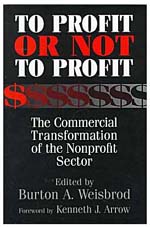 (Reprinted with permission from Philanthropy Monthly, written by Pete Dobkin Hall.)
(Reprinted with permission from Philanthropy Monthly, written by Pete Dobkin Hall.)
This collection of fifteen essays (To Profit or Not to Profit: The Commercial Transformation of the Nonprofit Sector)—three by Northwestern University economist Burton A. Weisbrod, five co-authored by him, and the balance by such illuminati as Estelle James, Dennis R. Young, Walter W. Powell, and Helmut Anheier, among others—documents and decries the increasing commercialization of the nonprofit sector.
The volume casts a broad net, seeking not only to examine such cross-cutting issues as competition, organizational behavior, the likely impact of changes in tax policy, and changes in ownership form, but also the dimensions of commercialization in particular industries. Though providing informed and insightful perspectives on an unquestionably important set of issues, the book is not without its faults—particularly the absence of any historical dimension.
Treating the organizational universe as though it began with the post-World War II tax and regulatory regime that created today’s charitable, tax-exempt universe is a serious flaw, since it prevents Weisbrod and his colleagues from assessing the significance of the current “commercial transformation” that they find so problematic. Historical benchmarks would have enabled them not only to consider the fact that many of our oldest nonprofit institutions—private universities and hospitals—have always derived most of their revenues from user fees, but also to examine the extent to which provision of arts, culture, education, health, welfare, and other services has shifted over time between government, proprietary, and nonproprietary agencies. These shifts have had less to do with the intrinsic nature of the services (as “public goods”) than with the ways in which public policy and consumer preferences have shaped and reshaped markets.
Few scholars have contributed more to our understanding of nonprofits over a longer period of time than Burt Weisbrod. His monograph, The Nonprofit Economy (1989), did more to move the portrayal of the nonprofit universe from the domain of myth to the domain of grounded social science than any other book published in the past thirty years. For this reason, finding the Tocquevillian myths that he so ably put to rest replaced with the questionable orthodoxies of contemporary law and economics theory is particularly troubling.
Though provocative and insightful, To Profit or Not to Profit ultimately tells us more about the intellectual limitations of contemporary nonprofits scholarship than about the realities and possibilities of American institutions.